cindy
Full Member
Posts: 226
|
Post by cindy on May 28, 2012 15:40:05 GMT
Cindy, I very much appreciate the work you are doing with Byblis. I love the genus, I wish I had more Byblis species in my collection. To me they are the most elegant and beautiful of the carnivores. (Of course, who can resist a nice Utricularia flower- really?) Your pictures are always a real treat! Thank you. Thanks! I am glad you enjoy the photos. There is a lot that I don't know about the genus. I try to post about the plants that are currently growing for me so that I can learn from the gurus. ;D |
|
cindy
Full Member
Posts: 226
|
Post by cindy on May 30, 2012 15:17:55 GMT
The first two fruits on the Byblis aff. filifolia have dried up and split. ;D
Fruit 1: selfed, no seed formed
Fruit 2: crossed with the B. filifolia with large lilac flowers, ~60 seeds formed
The seeds formed are not of uniform shape and size. I'll be sowing the seeds this weekend to see what the germination rate is like.
It would be interesting to see what turns out for the reverse cross where the large flower plant is the fruit bearer.
|
|
cindy
Full Member
Posts: 226
|
Post by cindy on Jun 1, 2012 10:33:11 GMT
B. filifolia "large lilac flowers".  B. liniflora (?) identified as B. aff. filifolia "flowers purple on both sides of petals" Theda Station, Kimberley. The fruits on the left - formed with pollen of the B. filifolia. Fruits on the right - from self-pollination. 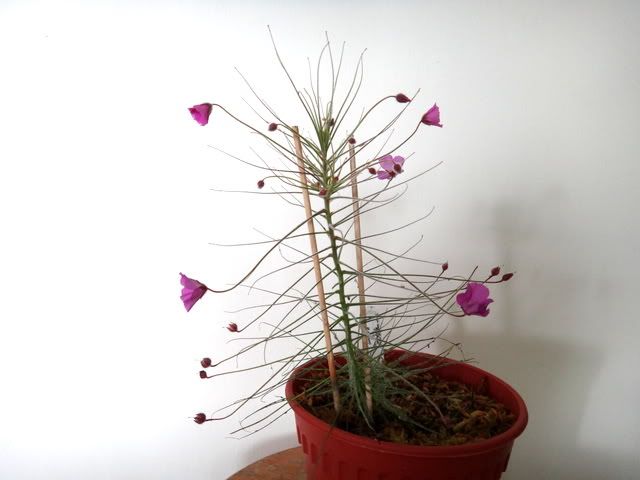 The two plants together for comparison. 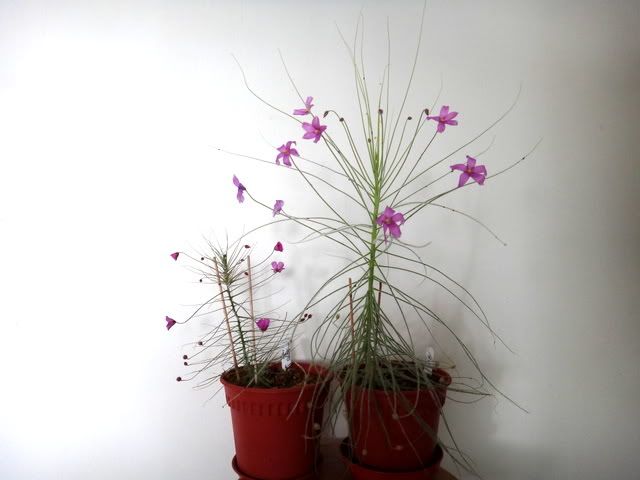 The seeds from the cross (B. aff. filifolia x B. filifolia). 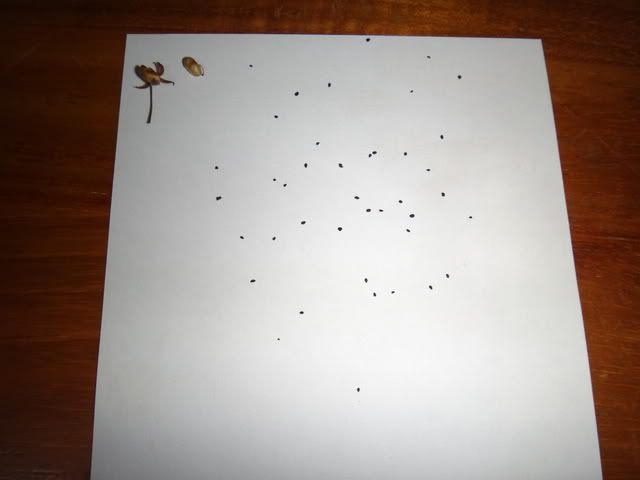 Seeds vary in size (the largest and the smallest) 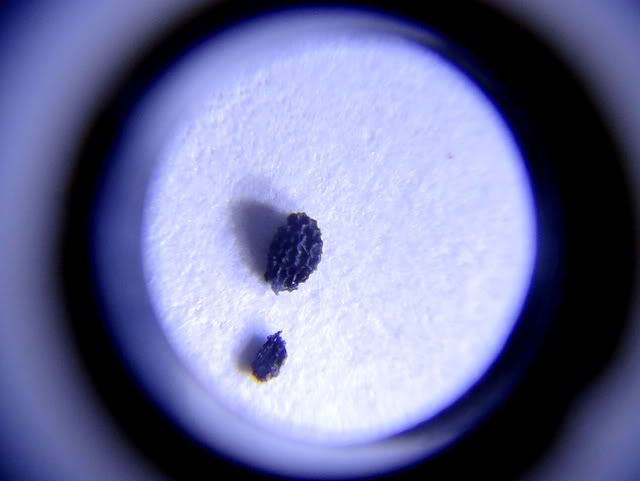 The seeds from B. filifolia "large lilac flowers" selfed 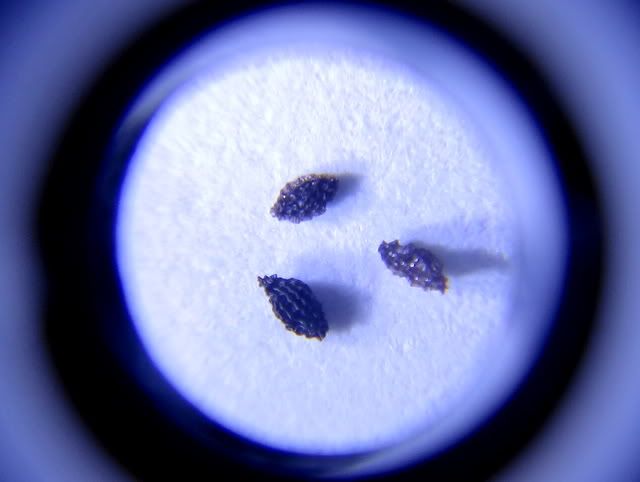 |
|
|
|
Post by Brian Barnes on Jun 4, 2012 13:54:28 GMT
Very interesting.
Now we have a self-pollinating Byblis filifolia. Hmmm...
Brian
|
|
sweetpea
Full Member
MOLLIE RILSTONE
Posts: 163
|
Post by sweetpea on Jun 5, 2012 0:11:20 GMT
|
|
cindy
Full Member
Posts: 226
|
Post by cindy on Jun 6, 2012 7:44:50 GMT
Thanks to Brian and sweetpea-san for the input.  Three seeds were formed in one fruit from selfing the B. filifolia "large lilac flowers". Since I pollinated the flower twice with a copious amount of pollen, the number of seeds from the selfing is kind of little. Two questions now come to mind.  1. Does cross-pollinating B. filifolia (whatever forms) give rise to a lot of seeds? 2. Is a high number of seeds indicative of species status/purity i.e. fillifolia x filifolia and not filifolia x guehoi? |
|
cindy
Full Member
Posts: 226
|
Post by cindy on Jun 8, 2012 13:15:34 GMT
Just an update after spending several hours studying the plants, counting the fruits and checking back on the records... B. filifolia "large lilac flowers" is very likely to be B. filifolia “giant plants to 50cm tall” Pago, Kimberley. The stem is thick at 1/4". The leaves are mostly about 19cm long. Pedicels are shorter than the leaves. Flowers are large, colour typical lilac/mauve colour on many Byblis plants. B. aff. filifolia has purple flowers and dark coloured sepals. The back of the flowers are purple too. Pedicels are longer than leaves and the plant branches. Results from self and cross pollination (at least 15 fruits from each plant)B. filifolia “giant plants to 50cm tall” Pago, Kimberley x B. filifolia “giant plants to 50cm tall” Pago, Kimberley - pedicels are lowered, fruits are round and seeds ARE formed B. aff. filifolia "purple flowers" x B. aff. filifolia "purple flowers" - pedicels are not lowered beyond the horizontal, fruits are oval and empty, seeds NOT formed B. filifolia “giant plants to 50cm tall” Pago, Kimberley x B. aff. filifolia "purple flowers" - pedicels are lowered, fruits are oval and empty, seeds NOT formed B. aff. filifolia "purple flowers" x B. filifolia “giant plants to 50cm tall” Pago, Kimberley - pedicels are lowered, fruits are round and seeds ARE formed What's baffled me  1. B. filifolia “giant plants to 50cm tall” Pago, Kimberley when selfed, produced seeds. However, sweetpea-san explained that being allogmaous does not mean self-sterile. 2. B. aff. filifolia "purple flowers" when selfed, produced no seeds. The plant is self-sterile...not too difficult to explain. 3. B. filifolia “giant plants to 50cm tall” Pago, Kimberley as the fruit bearer produced no seed while B. aff. filifolia "purple flowers" as the fruit bearer, produced a significant number of seeds. Hmm...has this got to do with the number of chromosomes? |
|
sweetpea
Full Member
MOLLIE RILSTONE
Posts: 163
|
Post by sweetpea on Jun 8, 2012 17:05:48 GMT
Dear Cindy-san, Konnichiwa!  I have encountered a number of interesting problems..... Byblis breeding is not all that simply...... Your result is very interesting! I have never got viable seed from "Pago giant",when selfed, although I have not tried self-pollinating it recent years. When I grow it in 1999, I got a small amount of seeds, even if cross-pollinating. It had a hard time though I recovered its health. Please go to: icps.proboards.com/index.cgi?board=byblis&action=display&thread=2348&page=1see photo3 and left hand of my wife May your research go well!!! Kind regards |
|
|
|
Post by leehsoon on Aug 14, 2018 18:14:25 GMT
My Byblis was bought 7 weeks ago, and it has grown well. However, I was told that it will only last a few months. Is that true? Is there any way I can help it to have a longer life span?
|
|
|
|
Post by ICPS-bob on Aug 14, 2018 18:39:30 GMT
|
|
|
|
Post by georgevance on Feb 3, 2019 15:10:34 GMT
Byblis filifolia and Byblis liniflora are well known. Widely distributed through the Kimberley region of Western Australia and extending into the Northern Territory. The distribution recorded by Lowrie & Conran (1998) shows some disjunctions.
The taxonomic status of the species has only recently been clarified and further locations would be
expected, as there is a larger area of suitable habitat.
|
|







